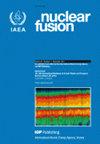The effect of shaping on trapped electron mode stability: an analytical model
IF 4
1区 物理与天体物理
Q1 PHYSICS, FLUIDS & PLASMAS
引用次数: 0
Abstract
A reduced model for trapped electron mode stability has been developed, which incorporates the basic effects of magnetic surface shaping, in particular, elongation and triangularity. This model shows that while elongation is stabilising, though weakly, negative triangularity usually leads to a more unstable plasma. This is in marked contrast with the experimental evidence of a better confinement at negative triangularity, and with recent gyrokinetic linear simulations. This paradox is solved when finite orbit and/or finite mode extent along field lines (mode ballooning) effects are included. These effects give more weight to particles trapped at low bounce angles, which are those that exhibit lower precession frequencies at negative—compared to positive—triangularity. As a result, the interchange growth rate becomes lower at negative triangularity and large temperature gradients, so that negative triangularity appears to have an overall stabilising effect. Mode ballooning appears to play the most important role in this reversal of stability.整形对困电子模式稳定性的影响:一个分析模型
我们建立了一个简化的受困电子模式稳定性模型,其中包含了磁表面塑形的基本效应,特别是伸长率和三角形效应。该模型表明,虽然伸长具有微弱的稳定作用,但负三角形通常会导致等离子体更加不稳定。这与实验证明负三角度时更好的约束性以及最近的陀螺动力学线性模拟形成了鲜明对比。如果将有限轨道和/或沿场线的有限模式范围(模式气球)效应包括在内,这一悖论就会迎刃而解。这些效应使低反弹角处的粒子受到更多的关注,这些粒子在负三角形时的前驱频率比正三角形时低。因此,在负三角形和大温度梯度条件下,交换增长率变低,所以负三角形似乎具有整体稳定效应。模式膨胀似乎在这种稳定性的逆转中发挥了最重要的作用。
本文章由计算机程序翻译,如有差异,请以英文原文为准。
求助全文
约1分钟内获得全文
求助全文
来源期刊

Nuclear Fusion
物理-物理:核物理
CiteScore
6.30
自引率
39.40%
发文量
411
审稿时长
2.6 months
期刊介绍:
Nuclear Fusion publishes articles making significant advances to the field of controlled thermonuclear fusion. The journal scope includes:
-the production, heating and confinement of high temperature plasmas;
-the physical properties of such plasmas;
-the experimental or theoretical methods of exploring or explaining them;
-fusion reactor physics;
-reactor concepts; and
-fusion technologies.
The journal has a dedicated Associate Editor for inertial confinement fusion.
 求助内容:
求助内容: 应助结果提醒方式:
应助结果提醒方式:


